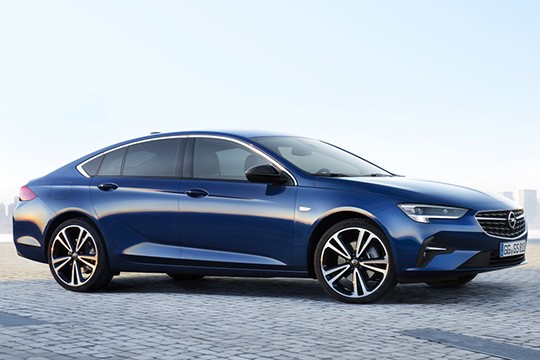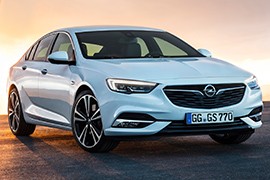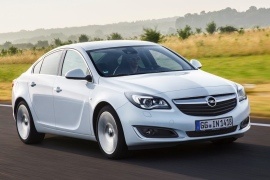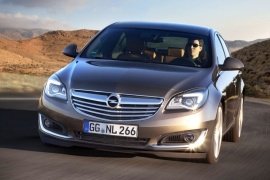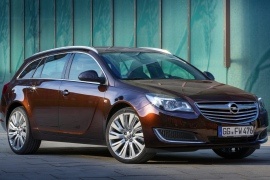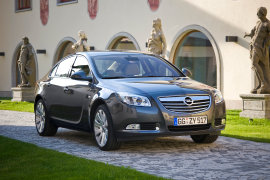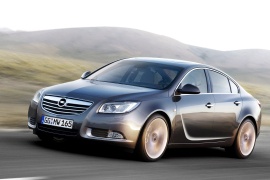OPEL Insignia Models/Series Timeline, Specifications & Photos
First production year: 2008
Engines: Diesel, Gasoline, Natural gas
Premiering at the 2020 Brussels Motor Show, the revamped Opel Insignia Grand Sport has been substantially refreshed both in terms of looks and the amount of technology available on the mid-size model. The main exterior modifications are found at the front, where extremely slim headlights with LED technology provide a major upgrade over the previous model.
The adaptive IntelliLux LED Pixel Light technology no offers no less than 84 LED elements per each headlamp, up from the previous model's 16, which means that the lights react a lot faster and with a lot more precision at any change in direction of driving without blinding the oncoming cars. This feature alone makes the revamped Insignia Grand Sport a unique proposition in its segment. The new radiator grille has a wider chrome edge, while the horizontal slats are more prominent, and alongside the new headlamp clusters and air inlets with integrated fog lamps make the car appear wider when viewed from the front. At the rear, the under guard panel now features two slim slots instead of round holes for the exhaust pipes, overall giving the car a cleaner look. As for the interior, the refreshed Insignia keeps the ergonomically certified AGR seats, which are still available for the driver and front passenger.
Opel introduced the second generation of the Insignia in 2017 and also revised the nameplate for the sedan version, which was now called "Grand Sport."
In March 2017, GM agreed to sell its European brands Opel and Vauxhall to the French automaker Peugeot. Before that, both brands had already launched the second generation of the Insignia in Europe and the UK. Thus, the flagship models of these brands ended GM ownership in style.
There was a new design trend in the industry. This time, the sharp lines and the sporty styling were on top of customers' lists. So, the Insignia Grand Sport showed a narrow front fascia with angular LED headlights adorned with double L-shaped daytime running lights. The grille sported chromed trims and the carmakers' round badge in the middle. From its profile, the Insignia Grand Sport boasted a sleek look, with one of the best aerodynamic coefficients on the market of just 0.26. That was also achieved thanks to the longer wheelbase than the car's previous generation.
Inside, Opel created a sophisticated cabin and an unusual instrument panel. Unlike most other vehicles from those times, the Insignia Grand Sport featured an ammeter and oil temperature gauges beside the regular water temperature and fuel level. Moreover, Opel tried to walk that extra mile to satisfy its clients and installed ergonomic front seats with electric adjustable bolstering settings. At the same time, the rear occupants were spoiled by the long wheelbase, and despite the sloped-down roof line, they had enough headroom.
Under the hood, the automaker installed a very wide choice of engines, ranging from a mundane 1.5-liter turbocharged unit to a healthy 260 PS (256 hp) powerplant. In addition, Opel also provided turbo-diesel engines.
In 2013, Opel decided to do a major facelift to its flagship, the Insignia. Since its launch, in 2008, Opel sold more than 500,000 units before the refreshed model. The facelifted version received new engines, a new infotainment system, and some exterior details.
On the front, on upper trim levels, the bi-Xenon headlights are offered as standard and the DRL are full-LED now. The side view of the 2013 Insignia sedan and hatchback were more differentiated than before through unique tailgates and integrated spoiler design. The roofline of the five-door model faded out not until it reaches the spoiler trailing edge to emphasize a classic coupe silhouette. On the four-door variant, the crease line continues along the edge of the spoiler to emphasize length on the elegant sedan. At the rear, new LED taillights are offered on all trim levels.
Inside, the AGR-certified seats are built for long roads. This certificate was obtained after proving to their ergonomic design will provide the best support for the spinal and the lumbar zone. A new infotainment system was installed, with an 8”screen in the central console. It can be accessed via voice commands, steering buttons or a touchpad.
The engine range starts with a new, 1.4-liter turbocharged gasoline engine that offers 140 hp. It is mated to a 6-speed manual. The 2013 Opel Insignia Sedan offered the choice between the three propulsion alternatives gasoline, diesel and LPG (Liquefied Petroleum Gas); power output ranges from 81 kW/110 hp to 239 kW/325 hp.
OPEL Insignia Sedan 1.4L Turbo ecoFLEX 6MT FWD (140 HP)
OPEL Insignia Sedan 1.6L Turbo ECOTEC 6AT FWD (170 HP)
OPEL Insignia Sedan 1.6L Turbo ECOTEC 6MT FWD (170 HP)
OPEL Insignia Sedan 2.0L Turbo ECOTEC 6AT AWD (250 HP)
OPEL Insignia Sedan 2.0L Turbo ECOTEC 6MT AWD (250 HP)
OPEL Insignia Sedan 2.0L Turbo ECOTEC 6MT FWD (250 HP)
OPEL Insignia Sedan 2.0L BiTurbo CDTI 6AT AWD (195 HP)
OPEL Insignia Sedan 2.0L BiTurbo CDTI 6AT FWD (195 HP)
OPEL Insignia Sedan 2.0L BiTurbo CDTI 6MT FWD (195 HP)
OPEL Insignia Sedan 2.0L CDTI 6AT (130 HP)
OPEL Insignia Sedan 2.0L CDTI 6AT 4x2 (163 HP)
OPEL Insignia Sedan 2.0L CDTI 6AT 4x4 (163 HP)
OPEL Insignia Sedan 2.0L CDTI 6MT (120 HP)
OPEL Insignia Sedan 2.0L CDTI 6MT (140 HP)
In 2013, Opel decided to do a major facelift to its flagship, the Insignia. Since its launch, in 2008, Opel sold more than 500,000 units before the refreshed model. The facelifted version received new engines, a new infotainment system, and some exterior details.
On the front, on upper trim levels, the bi-Xenon headlights are offered as standard and the DRL are full-LED now. The side view of the Insignia Hatchback shows an extension of the roofline towards the rear spoiler on the spoiler. The big opening of the liftgate reveals 530 liters (18.7 cu-ft) of trunk space, and that can be extended up to 1470 liters (52 cu-ft) by folding the backseats. In the rear, Opel installed new LED taillights that are offered as standard on all trim levels.
Inside, the AGR-certified seats are built for long roads. This certificate was obtained after proving to their ergonomic design will provide the best support for the spinal and the lumbar zone. A new infotainment system was installed, with an 8” touch-screen in the central console. It can be accessed via voice commands, steering buttons or a touchpad.
The engine range starts with a new, 1.4-liter turbocharged gasoline engine that offers 140 hp. It is mated to a 6-speed manual. The 2013 Opel Insignia Sedan offered the choice between the three propulsion alternatives gasoline, diesel and LPG (Liquefied Petroleum Gas); power output ranges from 81 kW/110 hp to 239 kW/325 hp.
OPEL Insignia Hatchback 1.4L Turbo ecoFLEX 6MT FWD (140 HP)
OPEL Insignia Hatchback 1.6L Turbo ECOTEC 6AT FWD (170 HP)
OPEL Insignia Hatchback 1.6L Turbo ECOTEC 6MT FWD (170 HP)
OPEL Insignia Hatchback 2.0L Turbo ECOTEC 6AT AWD (250 HP)
OPEL Insignia Hatchback 2.0L Turbo ECOTEC 6MT AWD (250 HP)
OPEL Insignia Hatchback 2.0L Turbo ECOTEC 6MT FWD (250 HP)
OPEL Insignia Hatchback 2.0L BiTurbo CDTI 6AT AWD (195 HP)
OPEL Insignia Hatchback 2.0L BiTurbo CDTI 6AT FWD (195 HP)
OPEL Insignia Hatchback 2.0L BiTurbo CDTI 6MT FWD (195 HP)
OPEL Insignia Hatchback 2.0L CDTI 6AT AWD (163 HP)
OPEL Insignia Hatchback 2.0L CDTI 6AT FWD (130 HP)
OPEL Insignia Hatchback 2.0L CDTI 6AT FWD (163 HP)
OPEL Insignia Hatchback 2.0L CDTI 6MT AWD (163 HP)
OPEL Insignia Hatchback 2.0L CDTI 6MT FWD (120 HP)
Five years after introducing the Insignia nameplate in Opel’s inventory, the German automaker unveiled the refreshed version of it, which affected all bodywork variants, including the Sports Tourer.
Opel was still under GM management when it launched the Insignia in 2008 to replace the Vectra lineup, a model that seemed to fade away in customers’ preferences. The automaker made the new model based on the same platform as the Buick Regal and the Holden Commodore. Unfortunately, the world financial crisis that plagued the automotive industry led to big losses for Opel, barely dodging the bankruptcy bullet. After 2011, when the European economy started to rise again, the German brand’s sales grew, and the car manufacturer tried to keep that trend going by introducing a refreshed version of its flagship model.
The 2013 Insignia Sports Tourer featured redesigned headlights that sported new LEDs for the daytime running lights, which kept the straight upper outer corner but sported a waved shape on the lower side. Between them, the automaker installed the broad grille that sported a thicker slat at the top followed downwards by three other horizontal bars. Underneath it, on the lower side of the bumper, the automaker added enlarged side intakes underlined by chromed trims.
From its profile, the long-roof version of the Insignia sported a chrome trim around the windowline and black B- and C-pillars. The sculptured doors featured a curved line that descended on the front ones and ran along the rear ones. At the back, a racked forward tailgate adorned by a roof spoiler tried to create a sportier look for the 16-foot (4,91-meter) long vehicle. Opel chose to install the taillights on the tailgate, and when customers opened it, a second set of lights remained fixed on the rearmost pillars. Finally, under the bumper, depending on the engine version, the car featured a single exhaust or dual ones mounted on the sides.
Inside, the 2013 Insignia Sports Tourer greeted its customers with one of the best front bucket seats on the market. These were separated by a tall and wide center console that housed the gear stick and a rotary knob that controlled the infotainment system. The center stack looked cleaner than before, with fewer buttons. In front of the driver, the binocular-style instrument cluster featured individual binnacles for the speedometer, the tachometer, the fuel gauge, and the coolant temperature indicator. In addition, a TFT display sat in the middle, showing data from the onboard computer. In the back, the Sports Tourer provided more headroom than the Insignia hatchback. Three passengers could sit comfortably on the split-folding bench and charge their laptops from a regular 220-volt outlet. In the back, the large trunk boasted 541 liters (19.1 cubic feet) of space.
Under the hood, Opel installed a wide choice of diesel and gasoline engines paired with manual or automatic gearboxes. Besides the front-wheel drive versions, the automaker also offered the car with all-wheel drive models, depending on the engine.
OPEL Insignia Sports Tourer 1.4L LPG ecoFLEX 6MT FWD (140 HP)
OPEL Insignia Sports Tourer 1.4L Turbo ecoFLEX 6MT FWD (140 HP)
OPEL Insignia Sports Tourer 1.6L Turbo ECOTEC 6AT FWD (170 HP)
OPEL Insignia Sports Tourer 1.6L Turbo ECOTEC 6MT FWD (170 HP)
OPEL Insignia Sports Tourer 2.0L Turbo ECOTEC 6AT AWD (250 HP)
OPEL Insignia Sports Tourer 2.0L Turbo ECOTEC 6MT AWD (250 HP)
OPEL Insignia Sports Tourer 2.0L Turbo ECOTEC 6MT AWD (250 HP)
OPEL Insignia Sports Tourer 2.0L BiTurbo CDTI 6AT AWD (195 HP)
OPEL Insignia Sports Tourer 2.0L BiTurbo CDTI 6AT FWD (195 HP)
OPEL Insignia Sports Tourer 2.0L BiTurbo CDTI 6MT FWD (195 HP)
OPEL Insignia Sports Tourer 2.0L CDTI 6AT AWD (163 HP)
OPEL Insignia Sports Tourer 2.0L CDTI 6AT FWD (130 HP)
OPEL Insignia Sports Tourer 2.0L CDTI 6AT FWD (163 HP)
OPEL Insignia Sports Tourer 2.0L CDTI 6MT AWD (163 HP)
OPEL Insignia Sports Tourer 2.0L CDTI 6MT FWD (120 HP)
The 2008 Opel Insignia was revealed at the 2008 London Motor show together with its UK sibling, the Vauxhall Insignia, and it was an important change from the aging Vectra.
While the Vectra's image as a mid-size vehicle was not that good anymore, the carmaker tried to change direction and offered a larger car. It made it in three body shapes: sedan, hatchback, and station wagon.
At the time of its launch, the Insignia was offered in two body versions: a hatchback and a classic, three-box sedan. At the front, the fresh design look and the corner-like daytime running lights placed inside the headlights created a fresh image for the Insignia. In its hatchback shape, it looked more like a fastback than a regular two-and-a-half vehicle. That shape helped the car achieve an excellent drag coefficient of just 0.27.
The interior was build from scratch. Its front seat seatbacks were thicker by 2 cm (0.8"), offering softer support for their occupants. The rear knee room was bigger by 3 cm (1.2") than the outgoing Vectra. A new infotainment generation included a seven-inch color monitor with a 3-D map view, digital travel guide, and improved scroll and zoom functions. Thanks to its split-bench system, the owner could have increased the trunk size from 530 liters (18.7 cu-ft) up to 1,430 liters (50.1 cu-ft).
Opel installed an extensive engine range on the Insignia. The base version featured a 1.4-liter turbocharged unit, while a 2.8-liter turbocharged V-6 powered the most potent version. The Insignia was available with either front or all-wheel-drive.
OPEL Insignia Hatchback 1.4L Turbo ecoFLEX 6MT FWD (140 HP)
OPEL Insignia Hatchback 1.6L Turbo ECOTEC 6AT FWD (170 HP)
OPEL Insignia Hatchback 1.6L Turbo ECOTEC 6MT FWD (170 HP)
OPEL Insignia Hatchback 2.0L Turbo ECOTEC 6AT 4x4 (250 HP)
OPEL Insignia Hatchback 2.0L Turbo ECOTEC 6MT 4x4 (250 HP)
OPEL Insignia Hatchback 2.0L Turbo ECOTEC 6MT FWD (250 HP)
OPEL Insignia Hatchback 2.0L BiTurbo CDTI 6AT 4x2 (195 HP)
OPEL Insignia Hatchback 2.0L BiTurbo CDTI 6AT 4x4 (195 HP)
OPEL Insignia Hatchback 2.0L BiTurbo CDTI 6MT (195 HP)
OPEL Insignia Hatchback 2.0L CDTI 6AT (130 HP)
OPEL Insignia Hatchback 2.0L CDTI 6AT 4x2 (163 HP)
OPEL Insignia Hatchback 2.0L CDTI 6AT 4x4 (163 HP)
OPEL Insignia Hatchback 2.0L CDTI 6MT 4x2 (163 HP)
OPEL Insignia Hatchback 2.0L CDTI 6MT 4x4 (163 HP)
The 2008 Opel Insignia was revealed at the 2008 London Motor show and it was an important change from the aging Vectra. The car-maker didn't only change the name, it shifted the direction.
Opel needed a larger car than the Vectra. It was needed to offer more interior room. But it didn't want to use the Vectra anymore. It was time to move on and so, it did it with the new Insignia. A car that offered more than a Vectra and came with a clean sheet design that was far from what the medium-sized Opels were before.
At the time of its launch, the Insignia was offered in two body versions: a hatchback and a classic, three-box sedan. The sloped rear of the later made it look like a hatch, but the trunk lid was opened independently from the rear window. The sculptured side panels and doors visually increased the length of the car. The headlights were aggressive and featured daytime running lights. All the efforts of the designers toward the aerodynamics paid off with a spectacular Cd of 0.27.
The interior was build from scratch and not even the previously used materials didn't found a place to be used. The front seat seatbacks were thicker by 2 cm (0.8”), offering softer support for their occupants. The rear knee room was bigger by 3 cm (1.2”) than of the outgoing Vectra. A new infotainment generation included a seven-inch color monitor, with 3-D map view, a digital travel guide and improved scroll and zoom functions.
The 2008 Opel Insignia featured a wide range of engines, from a small 1.6-liter gasoline unit up to a 2.8-liter V6 unit. For the diesel fans, it offered three versions of a 2.0-liter turbodiesel. Front or all-wheel-drive systems were available for selected versions.
OPEL Insignia Sedan 1.4L Turbo ecoFLEX 6MT (140 HP)
OPEL Insignia Sedan 1.6L Turbo ECOTEC 6AT (170 HP)
OPEL Insignia Sedan 1.6L Turbo ECOTEC 6MT (170 HP)
OPEL Insignia Sedan 2.0L Turbo ECOTEC 6AT 4x4 (250 HP)
OPEL Insignia Sedan 2.0L Turbo ECOTEC 6MT (250 HP)
OPEL Insignia Sedan 2.0L Turbo ECOTEC 6MT 4x4 (250 HP)
OPEL Insignia Sedan 2.0L BiTurbo CDTI 6AT 4x4 (195 HP)
OPEL Insignia Sedan 2.0L BiTurbo CDTI 6MT (195 HP)
OPEL Insignia Sedan 2.0L BiTurbo CDTI AWD 6AT 4x2 (195 HP)
OPEL Insignia Sedan 2.0L CDTI 6AT (130 HP)
OPEL Insignia Sedan 2.0L CDTI 6AT 4x2 (163 HP)
OPEL Insignia Sedan 2.0L CDTI 6AT 4x4 (163 HP)
OPEL Insignia Sedan 2.0L CDTI 6MT (120 HP)
OPEL Insignia Sedan 2.0L CDTI 6MT (140 HP)
